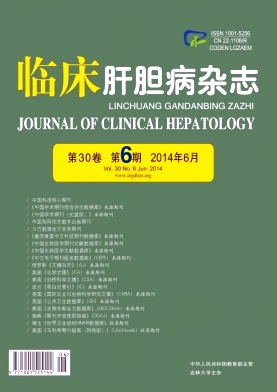|
[1]WHO.Guidelines for the screening, care and treatment of persons with hepatitis C infection[M].WHO Press, 2014:5-122.
|
|
[2] CHEN YS, LI L, CUI FQ, et al.A sero-epidemiological study onhepatitis C in China[J].Chin J Epidemiol, 2011, 32 (9) :888-891. (in Chinese) 陈园生, 李黎, 崔富强, 等.中国丙型肝炎血清流行病学研究[J].中华流行病学杂志, 2011, 32 (9) :888-891.
|
|
[3] SMITH DB, BUKH J, KUIKEN C, et al.Expanded classification of hepatitis C virus into 7 genotypes and 67 subtypes:updated criteria and genotype assignment Web resource[J].Hepatology, 2014, 59 (1) :318-327.
|
|
[4]THOMAS DL.Global control of hepatitis C:where challenge meets opportunity[J].Nat Med, 2013, 19 (7) :850-858.
|
|
[5]MANNS MP, von HAHN T.Novel therapies for hepatitis C-one pill fits all?[J].Nat Rev Drug Discov, 2013, 12 (8) :595-610.
|
|
[6]ENOMOTO N, SAKUMA I, ASAHINA Y, et al.Comparison of full-length sequences of interferon-sensitive and resistant hepatitis C virus 1b.Sensitivity to interferon is conferred by amino acid substitutions in the NS5A region[J].J Clin Invest, 1995, 96 (1) :224-230.
|
|
[7]RAO H, WEI L, LOPEZ-TALAVERA JC, et al.Distribution and clinical correlates of viral and host genotypes in Chinese patients with chronic hepatitis C virus infection[J].J Gastroenterol Hepatol, 2014, 29 (3) :545-553.
|
|
[8]SHI X, PAN Y, WANG M, et al.IL28B genetic variation is associated with spontaneous clearance of hepatitis C virus, treatment response, serum IL-28B levels in Chinese population[J].PLoS One, 2012, 7 (5) :e37054.
|
|
[9]THOMAS DL, THIO CL, MARTIN MP, et al.Genetic variation in IL28B and spontaneous clearance of hepatitis C virus[J].Nature, 2009, 461 (7265) :798-801.
|
|
[10]TANAKA Y, NISHIDA N, SUGIYAMA M, et al.Genome-wide association of IL28B with response to pegylated interferon-alpha and ribavirin therapy for chronic hepatitis C[J].Nat Genet, 2009, 41 (10) :1105-1109.
|
|
[11]SUPPIAH V, MOLDOVAN M, AHLENSTIEL G, et al.IL28B is associated with response to chronic hepatitis C interferon-alpha and ribavirin therapy[J].Nat Genet, 2009, 41 (10) :1100-1104.
|
|
[12]GE D, FELLAY J, THOMPSON AJ, et al.Genetic variation in IL28B predicts hepatitis C treatment-induced viral clearance[J].Nature, 2009, 461 (7262) :399-401.
|
|
[13]PROKUNINA-OLSSON L, MUCHMORE B, TANG W, et al.A variant upstream of IFNL3 (IL28B) creating a new interferon gene IFNL4 is associated with impaired clearance of hepatitis C virus[J].Nat Genet, 2013, 45 (2) :164-171.
|
|
[14]LINDENBACH BD, MEULEMAN P, PLOSS A, et al.Cell culturegrown hepatitis C virus is infectious in vivo and can be recultured in vitro[J].Proc Natl Acad Sci U S A, 2006, 103 (10) :3805-3809.
|
|
[15]ZHONG J, GASTAMINZA P, CHENG G, et al.Robust hepatitis C virus infection in vitro[J].Proc Natl Acad Sci U S A, 2005, 102 (26) :9294-9299.
|
|
[16]WAKITA T, PIETSCHMANN T, KATO T, et al.Production of infectious hepatitis C virus in tissue culture from a cloned viral genome[J].Nat Med, 2005, 11 (7) :791-796.
|
|
[17]GOTTWEIN JM, SCHEEL TK, JENSEN TB, et al.Development and characterization of hepatitis C virus genotype 1-7 cell culture systems:role of CD81 and scavenger receptor class B type I and effect of antiviral drugs[J].Hepatology, 2009, 49 (2) :364-377.
|
|
[18]LU J, TAO W, LI R, et al.Construction and characterization of infectious hepatitis C virus chimera containing structural proteins directly from genotype 1b clinical isolates[J].Virology, 2013, 443 (1) :80-88.
|
|
[19]LI YP, RAMIREZ S, JENSEN SB, et al.Highly efficient fulllength hepatitis C virus genotype 1 (strain TN) infectious culture system[J].Proc Natl Acad Sci U S A, 2012, 109 (48) :19757-19762.
|
|
[20]LI YP, RAMIREZ S, GOTTWEIN JM, et al.Robust full-length hepatitis C virus genotype 2a and 2b infectious cultures using mutations identified by a systematic approach applicable to patient strains[J].Proc Natl Acad Sci U S A, 2012, 109 (18) :e1101-e1110.
|
|
[21]LU J, XIANG Y, TAO W, et al.A novel strategy to develop a robust infectious hepatitis C virus cell culture system directly from a clinical isolate[J].J Virol, 2014, 88 (3) :1484-1491.
|
|
[22]YANG D, ZUO C, WANG X, et al.Complete replication of hepatitis B virus and hepatitis C virus in a newly developed hepatoma cell line[J].Proc Natl Acad Sci U S A, 2014, 111 (13) :e1264-e1273.
|
|
[23]WU X, ROBOTHAM JM, LEE E, et al.Productive hepatitis C virus infection of stem cell-derived hepatocytes reveals a critical transition to viral permissiveness during differentiation[J].PLoS Pathog, 2012, 8 (4) :e1002617.
|
|
[24]HUANG P, ZHANG L, GAO Y, et al.Direct reprogramming of human fibroblasts to functional and expandable hepatocytes[J].Cell Stem Cell, 2014, 14 (3) :370-384.
|
|
[25]YU B, HE ZY, YOU P, et al.Reprogramming fibroblasts into bipotential hepatic stem cells by defined factors[J].Cell Stem Cell, 2013, 13 (3) :328-340.
|
|
[26]BUKH J.Animal models for the study of hepatitis C virus infection and related liver disease[J].Gastroenterology, 2012, 142 (6) :1279-1287.e3.
|
|
[27]DORNER M, HORWITZ JA, DONOVAN BM, et al.Completion of the entire hepatitis C virus life cycle in genetically humanized mice[J].Nature, 2013, 501 (7466) :237-241.
|
|
[28]TAO WY, ZHANG Y, ZHONG J.Progress in the development of experimental animal models of HCV infection[J].Infect Dis Info, 2012, 25 (2) :71-74. (in Chinese) 陶万银, 张岩, 钟劲.HCV实验动物模型研究进展[J].传染病信息, 2012, 25 (2) :71-74.
|
|
[29]LIANG TJ.Current progress in development of hepatitis C virus vaccines[J].Nat Med, 2013, 19 (7) :869-878.
|
|
[30]KHAN AG, WHIDBY J, MILLER MT, et al.Structure of the core ectodomain of the hepatitis C virus envelope glycoprotein 2[J].Nature, 2014, 509 (7500) :381-284.
|
|
[31]KONG L, GIANG E, NIEUSMA T, et al.Hepatitis C virus E2 envelope glycoprotein core structure[J].Science, 2013, 342 (6162) :1090-1094.
|
|
[32]LEE YA, FRIEDMAN SL.Reversal, maintenance or progression:What happens to the liver after a virologic cure of hepatitis C?[J].Antiviral Res, 2014, 107C:23-30.
|







 DownLoad:
DownLoad: